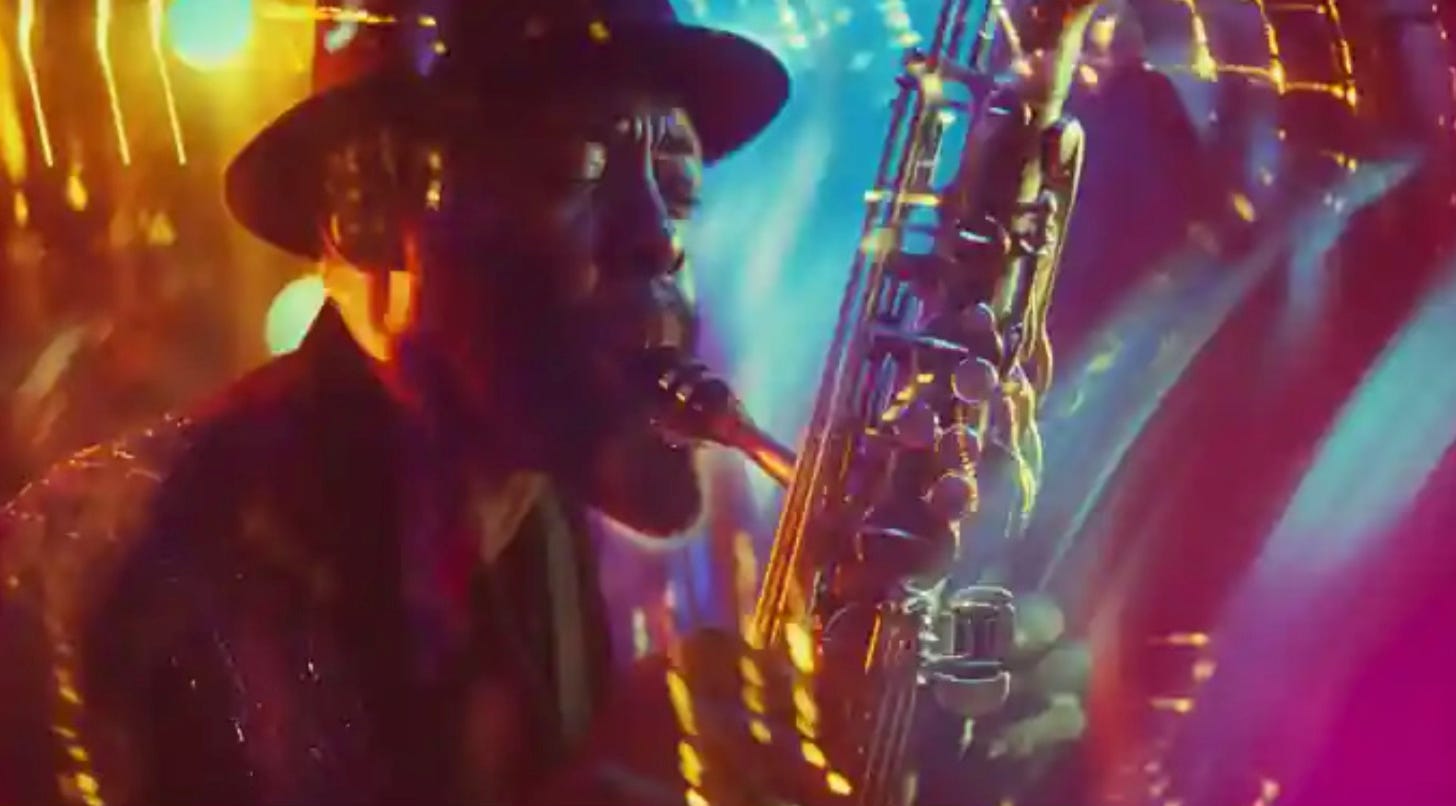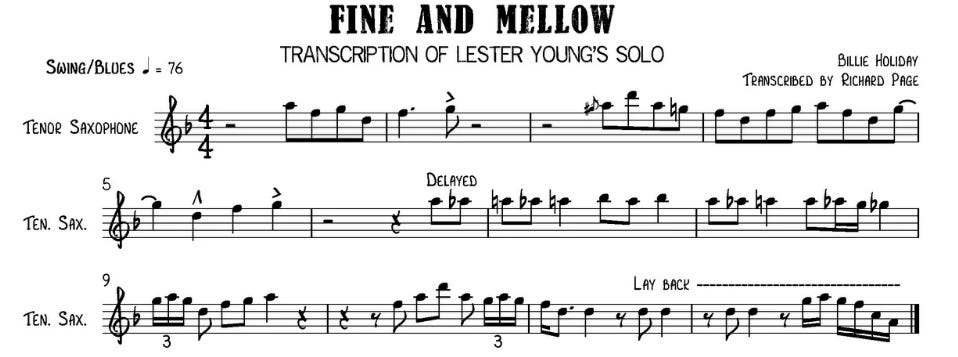I celebrated my 75th (!) birthday in Mexico City last week after a challenging July, during which I dove into the new world of AI filmmaking. To mark this milestone and celebrate my remarkable life, I’ve curated a collection of five of my all-time favorite jazz solos.
Here’s a revised version of your text, with some adjustments for clarity, flow, and impact:
---
The art of improvisation has always fascinated me. I believe it’s one of the most unique and memorable forms of expression for several reasons:
**Spontaneity and Creativity:** Jazz musicians create music in the moment, crafting solos and interactions in real-time. This spontaneity allows for a profound level of personal expression and creativity, making each performance a singular experience.
**Interaction and Communication:** Jazz improvisation is often a collaborative process, where musicians listen and respond to one another, creating a dynamic conversation through their instruments. This real-time interaction is a hallmark of the genre, adding depth and richness to the music.
**Complexity and Skill:** Improvising in jazz requires a deep understanding of music theory, including harmony, scales, and chord progressions. Musicians must be technically proficient and highly knowledgeable to navigate the intricate structures of jazz, demonstrating both their skill and intellect.
**Emphasis on Individual Style:** While many musical forms involve some level of improvisation, jazz places a significant emphasis on the individual voice. Musicians develop their own unique styles and vocabularies, making each performance distinct and deeply personal.
**Cultural and Historical Context:** Jazz improvisation has roots in African American musical traditions and reflects a rich cultural heritage. This historical context adds layers of meaning and depth to the improvisational practice, connecting it to a broader narrative of resilience and creativity.
**Emotional Expression:** Jazz improvisation allows musicians to convey a wide range of emotions, from joy and excitement to melancholy and introspection. The immediacy of improvisation can make these emotional expressions particularly powerful, resonating deeply with listeners.
**Freedom Within Structure:** Jazz balances freedom with structure. Musicians often improvise within established forms, such as the 12-bar blues or 32-bar song form, providing a framework for creativity while allowing for significant freedom.
These elements combine to make jazz improvisation a distinctive and influential art form that continues to captivate audiences and inspire musicians worldwide.
I’ve been listening to jazz seriously for over sixty years now. The inspiration and comfort I find in these solos continue to move me, even after countless encounters. For me, jazz is one of the few constants in life. If I’m down, it lifts me up. If I’m flying high, it takes me even higher. Unlike people, jazz never disappoints. I am deeply honored to have known the musicians I admire so much and to have made their music an essential part of my life.
I’m sure that anyone who truly listens to this music has developed their own favorites. Here are five of mine. Note: rather than include the entire track, I’m just posting the melody and then a solo. I encourage you to check out the complete performances, which are available on YouTube. And, if you like what I’m doing, drop me a comment, and I’ll produce more.
Michael Brecker - "Gregory Is Here"
I’ve always loved the music of Horace Silver, especially his 1973 release *In Pursuit of the 27th Man*, which features a twenty-three-year-old tenor saxophonist named Michael Brecker. Sometimes, you hear music that stops you in your tracks and demands your attention. If it's someone you haven't heard before, you find yourself wondering, "Who the hell was that?" This solo was my introduction to Michael Brecker, and it still blows my mind. I'm not one to analyze music; I just can't put it into words. But when it moves me, it creates an incredible feeling. In the years following my initial encounter with Mike, like many others, I became a huge fan. Eventually, I got to know Michael Brecker and can report that as great a musician as he became, he was an equally wonderful person. His passing at 58 was one of the great tragedies in this music.
“Gregory Is Here” is also one of my favorite Horace Silver compositions and the perfect example of his brilliance as an accompanist. The rhythm section includes Bob Cranshaw on bass and Mickey Roker on drums.
---
Keith Jarrett - Forest Flower
Here’s a revised version of your text with some adjustments for clarity and flow:
---
The Charles Lloyd recording “Forest Flower” was released in 1967, during my senior year of high school. I was already familiar with Charles Lloyd from his work with Cannonball Adderley and Chico Hamilton, and I had read about his quartet’s triumphant appearance at the Monterey Jazz Festival in 1966. So, as soon as this recording was released, I purchased it. “Forest Flower” was my introduction to the quartet, which featured Cecil McBee on bass, Jack DeJohnette on drums, and the pianist Keith Jarrett. Keith’s solo on the title track was another magical discovery for me.
When I moved to New York, I had the chance to hear the quartet live several times and began following Keith Jarrett’s career closely. I followed him as he formed his own groups and later played electric music with Miles Davis. The first time I heard him with Miles was unexpectedly at the *Miles at Fillmore* gig in 1970. Miles’ music was evolving at that time. I had heard the group several months earlier, also at the Fillmore East, during Wayne Shorter’s last gig with the band. At that time, Chick Corea was on piano, Dave Holland on bass, and Jack DeJohnette on drums (after he had left Charles Lloyd’s Quartet).
At the second Fillmore East gig, I didn’t know what to expect. The curtain went up, and the musicians began to fill the stage. There was Chick, Dave, Jack, and Airto, along with Steve Grossman on sax, and suddenly, at the other end, Keith Jarrett on a Farfisa Electric Organ. Holy cow!
Over the past half-century, Keith Jarrett has been recognized for his prodigious talent as a pianist, including recording the best-selling solo piano album in history, *The Köln Concert.* Mr. Jarrett is celebrated for his improvisational skills, often performing concerts that are entirely improvised. His spontaneity and creativity have set a high standard in the music world. For me, his technical prowess on the piano is matched only by his emotional expressiveness. His performances often convey a deep sense of emotion and spirituality.
---
Dexter Gordon - The Maze
Herbie Hancock’s Blue Note debut as a leader, Takin’ Off, was released in 1962. For this maiden voyage, he was joined by a stellar lineup: Freddie Hubbard, Dexter Gordon, Butch Warren, and Billy Higgins. Not a bad band for a debut!
Dexter Gordon was truly one of the greatest improvisers in jazz history, an incredible musical storyteller. The legendary tenor saxophonist had a warm, personable, and charming personality, which he authentically reflected in his playing like no other. His melodic and horizontal approach to soloing makes him a highly accessible musician. Characterized by naturally flowing lines and a relaxed (but extremely consistent) interpretation of the beat, "Long Tall Dexter’s" sound is instantly recognizable—most notably by his famously warm, wide tone and a volume befitting his 6'6" frame.
In addition to his mechanical expertise in bebop, Dexter’s romanticism also led him to master the art of the ballad. His ability to tell a story through music set him apart, allowing him to connect with listeners on a deeply emotional level.
John Coltrane - All Blues
March 22, 1960, Stockholm, Sweden. Miles Davis, composer, trumpet; Wynton Kelly, piano; Paul Chambers, bass; Jimmy Cobb, drums and John Coltrane on tenor saxophone.
After he decided to form his own group, Coltrane’s final tour with Miles was a European sojourn in the spring of 1960. Trane didn’t really want to make the tour, he only packed a small bag with a change of underwear. Thankfully, the music was documented because it featured some of his best playing. Which is saying a lot. His long, exploratory solos were the subject concern by Miles. The story goes that Miles once asked Trane why he took such long solos. Trane replied, I just don’t know where to stop. To which Miles replied, take the horn out ya mouth.
Lester Young - Fine and Mellow
This last one isn’t from a recording, but from the classic 1959 television program, The Sound of Jazz, featuring a truly remarkable lineups. As evidenced by what we see and hear, the musicians really came to play that Sunday afternoon. On Billie Holiday’s composition, Fine and Mellow, after she introduces the melody, Ben Webster takes the first solo. Then an incredible contrast, Pres, in just one chorus, plays one of the greatest moments in the history of this music. The perfect solo.







Bret - You have cited some really great solos. I shall revisit them soon. Of course, we all have our favorites. One I have always loved and have used to illustrate the ultimate in motivic development and solo structure is Sonny Rollin’s solo on “Without A Song” from his “The Bridge” album on the RCA label. His triumphant return from a self-imposed sabbatical.
I’m the guy that pushed Chet Baker out that window.
He asked me to. It’s gotta be part of the legend, you know. That’s what he said. His soul had been infested with termites and you could see it in the cracks of his face.
Chet, Chet, goddammit Chet, you gave us some good music
but you caught the wrong train outta town.
You were so high you didn’t hear the splat as your face hit the pavement.
Bye, Chet. Thanks, funny valentine.